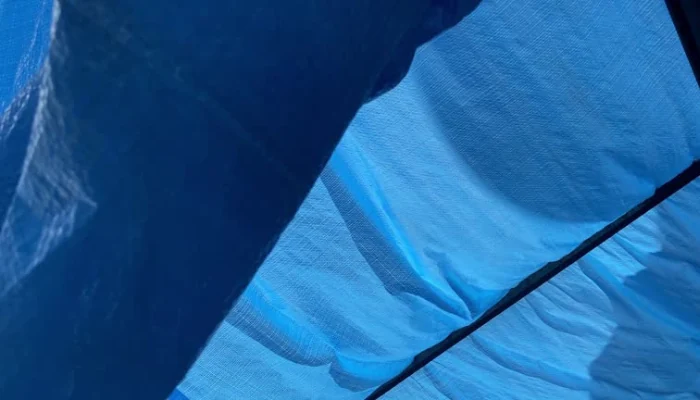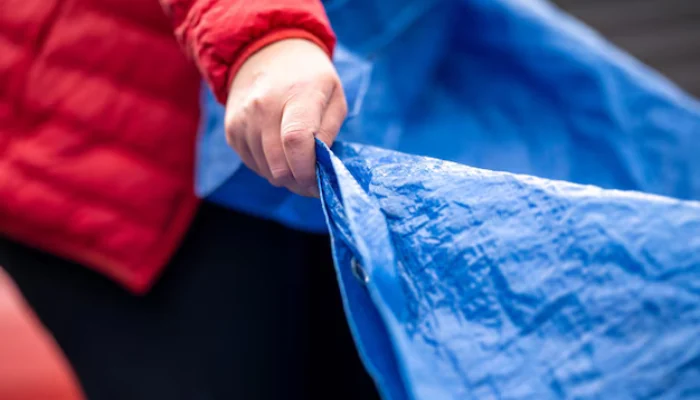How long will a tarp last in the sun? If you’ve ever used one to cover your roof, car or outdoor gear, you’ve probably asked the same thing. And for good reason: tarp sun exposure can cut its life short much faster than expected.
Direct UV rays can slash tarp durability by more than half. According to the National Weather Service, even a clear summer day can expose surfaces to UV levels strong enough to degrade plastics and fabrics within weeks. That means tarp UV resistance isn’t something you can ignore.
So, what makes one tarp last a full season while another starts cracking after a month? Is it the color? The thickness? The material? Or maybe how you use it?
In this guide, you’ll find clear answers backed by real numbers, expert tips from the team at Protect Preserve Roofing and simple ways to boost tarp lifespan, even under the hottest sun.
Also, you will learn which types of tarps hold up, which break dow, and how to stretch every dollar with smart use and maintenance.
Table of Contents
ToggleHow Long Will a Tarp Last in the Sun?
Short answer? Not long.
Blue tarp is made from polyethylene, a plastic that breaks down fast under UV rays. On average, a standard blue tarp will last about 3 to 9 months in constant sun before it starts ripping, fading or getting brittle. Leave it out for a year? Expect blue flakes scattered across your yard.
According to several manufacturers, blue tarps aren’t UV-rated. Therefore, don’t forget, they’re made for short-term fixes, not long-term protection.
What weakens a blue tarp in the sun?
Sunlight isn’t gentle. It cooks the plastic, dries it out, and turns it into something that feels more like paper than protection. Here’s what makes a blue tarp fall apart faster:
- Constant sun exposure (especially midday UV rays).
- Wind movement that causes flapping and small tears.
- Rain pooling, which adds stress to the material.
- Sharp edges or friction points under the tarp.
When is a blue tarp the right choice?
Even with a short lifespan, blue tarps still have their place. Use them if you:
- Just need a quick cover after a storm,
- Want to shield tools or supplies for a few weeks,
- Or need something affordable for temporary work.
Blue tarps are a solid option. But if you’re planning to leave it up through the summer heat or the wet season, it’s time to think about a better solution or at least a backup plan.
Quick reminder: We’ve seen too many homes where a blue tarp stayed too long. It’s a quick fix, don’t make it your only fix.
What Really Affects a Tarp’s Lifespan in the Sun?

Some tarps quit after a few months. Others hang in there for years. What’s the difference? It’s not luck. It’s all about the elements and how tarp durability works.
1. UV Rays: the silent killer
The sun doesn’t just heat up your tarp. It breaks it down. UV rays attack the plastic, making it brittle and weak. Tarps without UV resistance can start cracking after just a few weeks of direct exposure.
No UV protection? No chance under full sun.
2. Material quality
Not all tarps are made equal. Here’s how material affects tarp lifespan:
- Blue polyethylene: low-cost, low life expectancy (3–9 months).
- Vinyl or coated PVC: higher resistance, lasts 2–5 years.
- Canvas: breathable, but absorbs moisture and breaks down under heat.
- Iron Horse / heavy-duty poly: long-lasting, UV-resistant, more expensive.
Quick reminder: A $10 tarp won’t last like a $100 one. Simple as that.
3. How it’s installed
Let’s be real, a poorly installed tarp dies fast. If it’s flapping in the wind or rubbing against sharp corners, it’s living on borrowed time. Use 2x4s or straps to keep it tight and never nail straight through the plastic.
Pro tip from Protect Preserve Roofing: We’ve replaced too many torn tarps that were put up in a rush. Take ten more minutes to install it right, it could save you weeks of headaches.
How Long Will Different Types of Tarps Last in the Sun?
Choosing the right tarp means knowing how long each type can survive under the sun. Use this quick guide to compare tarp durability, lifespan, and UV resistance:
| Tarp Type | Sun Lifespan | UV Resistance | Best Use | Reality Check |
|---|---|---|---|---|
| Blue Polyethylene | 3 to 9 months | Low | Short-term cover, emergency patching | Cheap, fast solution – don’t expect it to last |
| Vinyl | 2 to 5 years | High | Long-term roof cover, heavy use | Heavy, more durable, worth the investment |
| Canvas | 1 to 3 years | Medium (if treated) | Shade, breathability | Needs treatment, absorbs moisture |
| Iron Horse / PVC | 5 to 10 years | Very High | Semi-permanent outdoor use | Most durable, higher cost, built for harsh sun |
Pro tip from Protect Preserve Roofing: You don’t need the most expensive tarp. You need the right one for the job. If it’s temporary, a blue tarp works. If it’s long-term, go stronger.
What Is the Lifespan of a Tarp? (And How to Extend It)

The word “lifespan” sounds like something fixed, but with tarps, it’s all about how you use them. Tarp lifespan depends on how it’s used. Even the best one will fail early if mistreated.
Here’s what affects how long it really lasts and what you can do to stretch it.
What shortens a tarp’s life?
- Leaving it loose: wind turns slack tarps into sails, and they rip fast.
- Nailing directly into it: every nail becomes a leak.
- Pooling water: adds weight and pressure.
- Dragging or folding over sharp edges: creates stress points that tear.
How to make it last longer?
- Use UV-protective spray (yes, it works).
- Install it tight, with 2x4s or straps (not nails).
- Remove it when not in use. Sunlight eats plastic every hour it’s exposed.
- Store it dry and folded flat in a cool place. Don’t wad it up.
Quick reminder: A $30 tarp can outlast a $100 one if it’s installed right and stored smart. We, at Protect Preserve Roofing, have seen it happen more than once.
Practical Tips to Make Your Tarp Last Longer
Most people throw a tarp on, cross their fingers and hope it holds. But if you want yours to last past a few weeks in the sun, here’s what actually works:
- Use UV-Protective spray: Yes, it makes a difference. A light coat every few months blocks the worst sun damage. Look for sprays made for plastic or outdoor fabrics.
- Keep it tight: Loose tarps don’t just flap, they rip. Use 2x4s, bungee cords, or ratchet straps. Avoid ropes that rub and cut into the edges.
- Watch for sharp edges: Metal gutters, roof corners, and fence posts can slice a tarp in no time. Add padding or fold extra material over high-friction spots.
- Never nail through the tarp: Use boards to hold it down. Don’t punch holes that create weak spots. One nail today = one leak tomorrow.
- Store it right: When you’re done, fold it dry, flat, and keep it out of the sun. Don’t toss it in a pile in the garage, moisture and heat will ruin it fast.
Pro tip from Protect Preserve Roofing: If a tarp is covering something important – like your home after a storm – it’s worth spending five extra minutes to do it right. Or better yet, give us a call and let us handle it.
Conclusion: Trusted Insights From the Experts at Protect Preserve Roofing
Blue tarps do a good job… for a while. But Florida’s sun won’t show mercy to lazy installs or cheap shortcuts. Whether you’re dealing with tarp sun exposure, checking tarp UV resistance or wondering how to stretch tarp lifespan, the solution is simple: use the right tarp and set it up right
We,’ve seen every kind of tarp fail: shredded by wind, baked by sun, soaked through by rain. And we’ve helped hundreds of homeowners fix it before things got worse.
Why trust our team?
- We know which tarp to use, and when to swap it.
- We secure it the right way, not the fast way.
- We don’t disappear after the job. We’re here when the next storm rolls in.
Don’t let a tarp be your final fix. If you’re using one right now, that’s your signal to call us. We’ll step in, protect your home, and take the guesswork out of what comes next.
Need help now? Contact Protect Preserve Roofing right now, just click here to get a fast, honest estimate and let us keep your home covered the right way.










